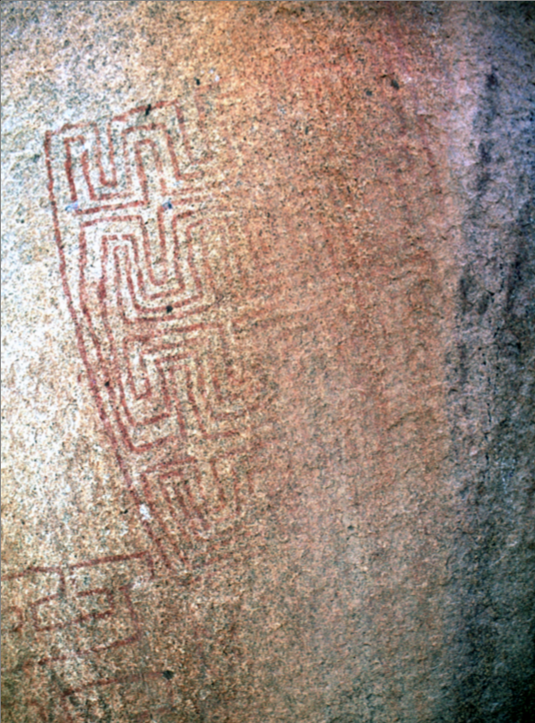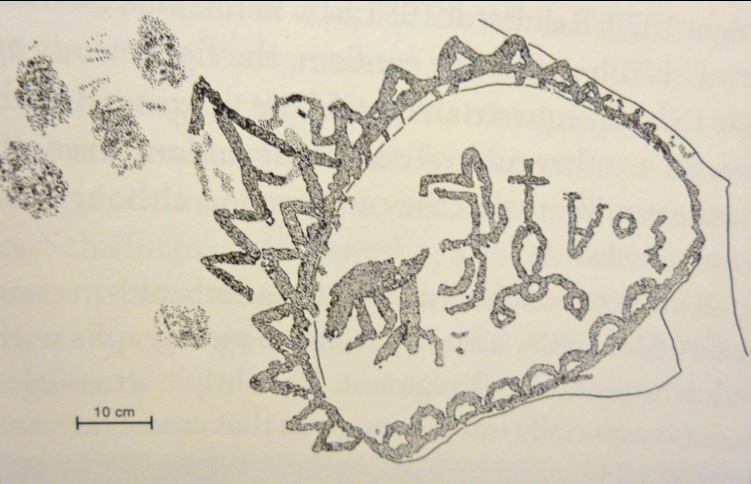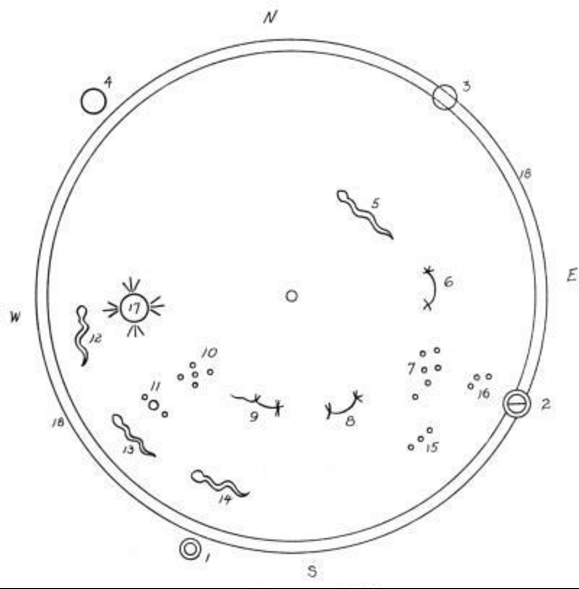Artistic Expression
Rock Art
We Kumeyaay have always been artists, painters, and a people who saw magic and wonderment in rocks. In some cases we added our personal, communal, or spiritual touch to nature. Our pictographs (rock paintings), petroglyphs (rock carvings), and geoglyphs (ground drawings) are a direct link with the Ancestors. These ancient art forms provide a link with the past.
Until recently Kumeyaay rock art (pictographs (paintings) and petroglyphs (carvings) were often portrayed as simplistic forms of largely unintelligible symbols. Increasingly, however, scholars such as Ken Hedges have been bringing new light on this ancient art form and offering more complex explanations of the deep spiritual and cosmological meanings of these fascinating art forms.
IMAGE PRODUCED BY BLOWING PIGMENT AROUND A HUMAN HAND
DESERT SPIRIT CIRCLE OR SPOKE WHEEL (GEOGLYPH)
In broad terms rock art in the county is categorized by stylistic elements (shapes and figures). The Rancho Bernardo Rectilinear Style is described as centered near the community of Rancho Bernardo and is exemplified by maze like designs and interlocking frets. The best known example of such sites is at Piedras Pintadas. The La Rumerosa style is based just south of Jacumba in Baja California at Vallecitos. This style includes anthropomorphs which are figures that blend animals and humans as well as geometric designs including circles, squares, and diamonds.
MAZE DESIGN PICTOGRAPH FROM RANCHO BERNARDO
As documented by Hedges and Ericson several of the rock art sites in San Diego contain shamanistic elements (birds, anthropomorphs, star bursts), portals for leaving or entering this world, and astronomical elements associated with the skies and with sky travel. Others are astronomical observatories marking the passage of heavenly bodies and celestial events (solstices/equinoxes). Others including so-called diamond chains are associated with girl’s puberty rights and some arts forms may be clan markings as reflected by depictions of shields. The “meanings” of the majority of rock art remain uncertain but they clearly reflect a desire to leave messages and images for future generations, and are rich artistic expressions. It has also been suggested that rock art was used to depict the Kumeyaay interaction with Spaniards in the early years of conflict (1769-1800). Examples include native depictions of men on horse/mule back, Christian crosses, and ships.
PICTOGRAPH FROM MISSION TRAILS REGIONAL PARK WITH CHRISTIAN MOTIFS
Besides being talented artists, Kumeyaay are chemists who, by necessity, manufactured their own paint. In composing their rock paintings the Kumeyaay used natural materials for pigments including ochre or iron oxide for red/orange, gray/white clay for white or gray, charcoal or magnesium for black, leafy plants for green, and flower petals for yellow. The oil base comes from the seeds of the wild green cucumber and the binder from cactus juices and/or stink bug juice. Blending pigment, oil, and binder together to form a cohesive paint requires knowledge of chemical components and their reaction to each other.
SAND PAINTINGS
Within the Kumeyaay world and paintings or sand drawings are used within certain ceremonies and rituals. The colored sands in the drawings consist of minerals of varying colors and textures carefully placed on a cleared surface to create designs. In addition to sand and minerals the drawings included shell, fiber, and seeds. In some instances milkweed or powdered soapstone was used to represent the Milky Way. The religious leader or kuseaay would meticulously construct the circles and the images within the circles in an ages old secret and pious ritual. It is important that the sand drawings be created afresh so that all of the participants can visualize its formation. Some of the elements in a sand drawing might include circles within which important or mythical animals and creatures were depicted as well as astronomical features especially the Milky Way. Waterman (1904) reported that there are two rattlesnakes that bisect the painting into east and west haves. The eastern snake is light colored with reddish iron oxide precipitated from a spring used for coloration. The western snake is black and made from burnt straw and charcoal.
During the toloache ceremony the ritual leader would reveal his sand painting. “He depicted the world with its mountains, rivers, and lakes; the rattlesnake, object of dread, and more terrible still because less understood, the figure of the Milky Way, Ha-tat-kurr signifying ‘backbone’ because it is the backbone of the sky (DuBois 1905:623). DuBois related that if the participants in the ceremony performed inaccurately or without sufficient reverence their backs could be suddenly broken or damaged.
BASKETS AND POTTERY
Two other media for art are Kumeyaay baskets and pottery. Weaving colorful patterns into a variety of basket forms produces geometric designs, animals, and insects. The colors are produced by dyeing basket fibers and then weaving the variegated colors into the structure of the basket. This rich tradition extends back thousands of years, even before ceramics, and continues today in vivid contemporary forms. Less commonly the Kumeyaay painted and incised their pottery vessels. Incision was accomplished when the clay is wet and unfired. Incised designs include cross hatches, diamond chains, circles, and straight lines. Most of the designs and motifs found on pottery also appear in rock art showing a cultural linkage regardless of medium.
KUMEYAAY BASKET DEPICTING RATTLESNAKE IMAGE
KUMEYAAY SAND PAINTING CIRCA 1910






